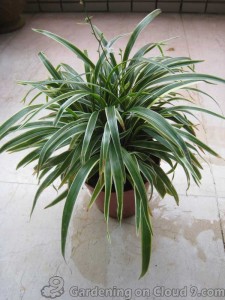|
|
By Sandy, on January 8th, 2010
Have you ever bought a Spider Plant (aka Airplane Plant, botanical name: Chlorophytum comosum) that just never grows “baby spiders”, or runners, no matter how well you take care of it? Instead of questioning your method of watering or fertilizing your Spider Plant, may be first of all, you should examine your plant and check whether or not it really is a Spider Plant! Because instead of a Spider Plant, it could be a Bichetii Grass.

Bichetii Grass (aka False Lily Turf, Siam Lily, botanical name: Chlorophytum bichetii) is in the same genus as Spider Plant, a very common variegated form of Chlorophytum laxum. Continue reading Is It Really a Spider Plant? Or a Bichetii Grass?
By Sandy, on April 18th, 2009
While we are familiar with the common names of our houseplants, most of us do not know the botanical name of our plants. This is totally fine, for it is absolutely not necessary to memorize those long, daunting botanical names. We can just use the botanical names for reference when looking up information of our plants in guidebooks or websites. Here are the reasons why we use botanical names for plant identification.
Botanical Name of a Plant – The Breakdown
The botanical name of a plant is composed of two major parts, the genus and the species of the plant. For simplicity’s sake, genus is the family and species is a member of the family.
Continue reading Botanical Name – What is in the name?
By Sandy, on April 18th, 2009
While common name is so much easier for us to use, there are several good reasons for us to use botanical names for plant identification.
Botanical Name – Unique to Only One Plant
Every plant has at least one unique botanical name (or scientific name or Latin name) to it. This means that every botanical name refers to one and only one plant. Some plants may have more than one botanical name, yet this is not very common. To avoid confusion, it is better to use botanical name for plant identification.
Continue reading Why Do We Use Botanical Names?
|
|




Recent Comments